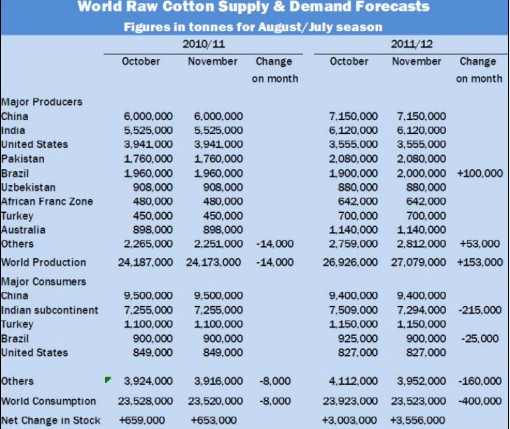|
LAHORE (December 10, 2010) : Cotton sales have slowed down since the past few days due to easier sentiment on New York futures (ICE) market, a spate of holidays ahead entailing business and industries closure for several days, year-end blues due to arriving of bank closures for balancing their books, fear of any untoward incident during incoming Muharram religious observations (16th and 17th of December, 2010) lower yarn and textile advices and uncertainty regarding imposition of the Reformed General Sales Tax (RGST) on textile items. Anticipated closure during the Chinese New Year in January 2011 is also being factored into the business slowdown syndrome. With New York Cotton Futures (ICE) mostly expected to remain range bound for the time being, spinners in Pakistan are only reported to be making moderate enquiries for imported cottons for the time being. Fear of any strife during Muharram is also shadowing the business sentiment for the near future. Yarn sales are also reported to have tempered down presently, thus making domestic spinners cautious in their cotton buying. Later on, the closure on the twenty fifth of December, 2010 for the birthday of Quaid-e-Azam Mohammad Ali Jinnah, founder of Pakistan, which is also Christmas day, will also reduce the business activity. Cotton arrivals will slow down for the holidays, but foggy weather in the fields will also slow down picking of cotton to some extent. News that the European Union (EU) is delaying passing the law for concessionary exports of some items to the EU is also causing consternation in trade circles who blame the Bangladesh and Indian government in preventing the EU to allow certain categories of textile exports from Pakistan to Europe. The perception in Pakistan is that for the time being New York cotton futures (ICE) prices are likely to remain mostly range bound. Moreover, mills are awaiting a definitive policy on the part of the Indian government regarding any resumption of its virtual ban on cotton exports. In Pakistan, we expect the current cotton crop (2010-2011) to yield anywhere from 10.50 to 11.25 million domestic size bales on an ex-gin basis from which about 400,000 to 500,000 bales are likely to be exported. Domestic mills are likely to consume between 14.5 million to 15 million domestic size bales during the current season (August 2010-July 2011). Under the prevailing scenario, Pakistan mills are expected to import anywhere between 2.5 million to 3.5 million bales (170 Kgs) for the prevailing season. It is thus envisaged that domestic mills will become more active buyers of cotton, both local and imported, some time early next year (2011). Seedcotton (Kapas/Phutti) prices were reported to be barely stable and ranged between Rs 3,800 to Rs 4,000 per 40 Kgs in Sindh and also in the Punjab. Lint prices in both Sindh and Punjab reportedly ranged between Rs 8,500 to Rs 9,000 per maund (37.32 Kgs) on Thursday with noticeably easy price tone. Media reports indicate that in a meeting on last Wednesday All Pakistan Textile Mills Association (APTMA) chairman Gohar Ejaz impressed upon President Asif Ali Zardari the futility of imposing the Reformed General Sales Tax (RGST) on textile goods as most of them are exported and bulk of the tax collection has to be refunded. Thus it is learnt that President Zardari has assured APTMA Chairman that textile exports will remain under zero rating. In any case, there is a wide spread opposition and resentment from different business and industrial quarters on imposing the RGST on existing assessees and who are demanding tax imposition on hitherto exempted trades and vocations like agriculture, property and a host of retailing enterprises. Gohar Ejaz had been called by President Zardari to make a suitable presentation on the RGST as pertaining to the textile industry. As a consequence, President Zardari is reported to have assured APTMA that the government would not adopt any measure which would upset the textile industry which by far remains the leading exporter exporting fifty five percent of the country's exports. President Zardari also assured the exporters that zero-rating of the intermediary textile processes will be maintained and that the RGST would only be charged on the domestic sales of garments. In view of the clearly bearish sentiment, Karachi Cotton Association (KCA) slashed its ex-gin price of grade three cotton by a whopping Rs 400 per maund (37.32 Kgs) on Thursday and determined it at Rs 8,800 per maund, a sharp drop indeed. One may note that considerable quantities of cotton from the domestic crop are currently cheaper than the prices of imported cottons. Brokers added in the evening that there was quiet in the market and the appearance was thus of calm. Lint prices reportedly ranged between Rs 8,500 to Rs 8,700 per maund (37.32 Kgs) in Sindh with upper Sindh (K-68) ginners still asking for Rs 9,000 per maund, while in the Punjab cotton prices were said to have ranged from Rs 8,500 to Rs 9,000 per maund in a subdued market. By the evening, 200 bales of cotton from Nawabshah in Sindh were said to have been sold at Rs 8,500 per maund (37.32 Kgs). In the Punjab, 400 bales from Harunabad reportedly sold at Rs 8,600 per maund, 200 bales from Chistian and 400 bales from Hasilpur sold at Rs 8,700 per maund, 200 bales from Tibba Sultan and 600 bales from Chistian both sold at Rs,8,800 per maund, while 200 bales each from Kucha Khu and Liaqatpur both sold at Rs 9,000 per maund. On the global economic and financial front, performance by leading countries as well as smaller countries remained very worrisome. To begin with, Federal Reserve Chairman Ben Bernanke said that it would take more time before the United States starts on a path to economic recovery. Thus President Obama plans to continue tax cuts for the Americans on a universal basis. Furthermore, Quantitative Easing (QE-3) would be necessarily enhanced to finance the slow moving economic recovery in the United States. In this regard, the Chinese Central Bank adviser Li Daoukui warned that though the United States dollar is presently holding the fort due to continuing economic troubles in the Euro Zone, the health of the United States economy is worse than that of Europe. Daokui fears that once the Euro Zone economy stabilises, the value of the bond prices and the dollar would fall. Besides the boom and bust story of Ireland, Iceland, Spain, Greece and Portugal in addition to some other European countries, now Germany 's bond prices, a safe haven, have risen with the fear that the economic adversities in the Euro Zone could sooner or later engulf Germany, Europe's largest economy. On the other hand, the United States bonds suffered their biggest selloff since the year 2008 indicating loss of confidence in the status of the American economy. Added to these troubles are the subpoenas issued by the US government to several hedge funds concerning their various lapses. To add to his roster of woes, we now hear of a telecom scandal in India which could cost the country a record United States dollars forty billions in which a minister is reportedly involved. Thus serious economic malfunctions continue to haunt the global economic condition. Correction: In the cotton analysis published on Friday, 3rd of December, 2010, it was erroneously stated that some quantities new crop of (2011-2012) of lint may start arriving by February/March of 2011. The expectation is that some sowing of the new crop (2011-2012) may start in February/March 2011 and lint therefore will not arrive before June/July 2011, even that in moderate quantities. The error is regretted. |
|
Pace of business slows down on cotton market
Updated: 2010-12-10 Source: Business Recorder

Recommended News
Photo Gallery
Most Popular



